Table of Contents
INTRODUCTION
It is more important to choose the right pressure washer nozzle than even the PSI or GPM of your pressure washing unit. If you select a nozzle that projects too much pressure from the surface, you risk the damage of property like gouging chunks out of your wood deck, peeling paint from your car, and so on.
It’s the nozzle that makes the pressure in the water flow that hits your cleaning surface by restricting the water stream from a continuous pressure source, creating more speed(velocity), and more force(pressure) in the spray. Sometimes, you may have to experiment to know which nozzle works best for you, but it is better to be informed and have an idea before starting.
Both gas and electric washers are strong for cleaning. Ensure that you choose the correct pressure washer nozzle for the specific job at hand as it is vital to get the level of cleaning force that you want. Spray nozzles are universally color-coded for easy identification of the angle degree and the pressure released through the washer head. Many pressure washers have the regular yellow, green, red, and white spray tips as an accessory to the wand. The black nozzle takes care of soaping the surface, and the turbo nozzle joins wide water angle and pressure bursting up against the target surface.
TYPES OF PRESSURE WASHER NOZZLES, THEIR COLORS, AND SIGNIFICANCE
RED NOZZLE: 0 DEGREES
The red-colored pressure washer nozzle gives full blast with little cone spray. This nozzle emits a small but very concentrated stream of water and is mostly used for eliminating tough stains and debris from metal and concrete. The minimum spray can cover a small area in quite a short time but is designed to clean a particular spot. It is good for caked grime and stubborn stains. The precise pressure of this nozzle is capable of removing grass that is growing on driveways and sidewalks.
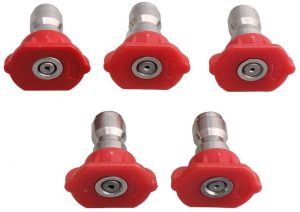
Make sure that you handle this nozzle with care and do not use it on wood or siding because the stream is quite powerful and may damage the surface.
YELLOW NOZZLE: 15 DEGREES
A yellow nozzle is a 15-degree washer tip that has a medium jet spry that can be used in preparing surfaces or removing stubborn dirt. It’s not as powerful or dangerous as the red nozzle but is used on most surfaces, and its spray angle covers more surface and areas.
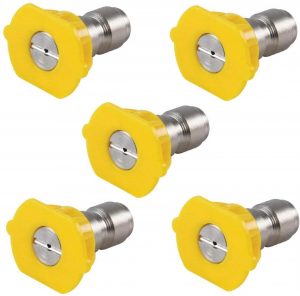
This nozzle is mostly used in heavy-duty cleanings like drains, concrete garage floors, and drains. They are also used in stripping paint, and their fan angle is small enough to remove mildew and dirt.
GREEN NOZZLE: 25 DEGREES
The green pressure washer nozzle is mostly used for washing and in-house cleaning chores. It has just enough pressure but with a broader fan of water that covers up more surface than the yellow nozzle. This nozzle washes dirt away from vinyl sidings, patios, and decks. It has a water-jet angle that is wide enough to wash away leaves from places around the house like driveways, decks, and paths. The pressure is just enough but still powerful enough to clean dirt from boats, cars, and trucks using chemicals and detergents. This nozzle is best for this as the yellow nozzle may be too strong to apply to a surface for chemical washing.
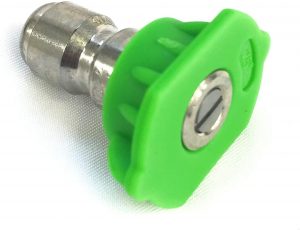
WHITE NOZZLE: 40 DEGREES
The white washer tip is the opposite of the red nozzle. It is designed to have a wide spraying pattern that allows for maximum spray at a low pressure that can be safely used on fragile and delicate surfaces. It has a 40-degree angle that covers a wide range of large surfaces very fast.
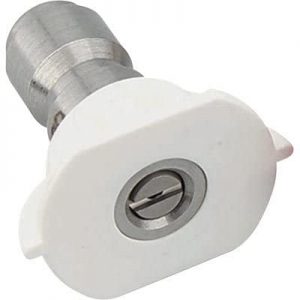
If you’re not sure whether to use the green nozzle for your boat or car, then you should probably opt for the white nozzle as its spray is gentler. But if you’re looking to clean tougher dirt and stubborn stains, then you need a higher spraying force. The white nozzle cleans gently and is mostly used for cleaning blinds, windows, and large areas quickly.
BLACK ATTACHMENT: 65 DEGREES
This nozzle is also known as a soaping blacktip or detergent nozzle. Unfortunately, at 65 degrees, the fan spray of the black nozzle tip provides external pressure, too low to remove dirt, debris, and mildew. It is suitable for wetting surfaces for the application of chemicals or detergent. It has a larger opening, which decreases its velocity and increases the pressure inside the hose, which in turn forces soap or detergent into the line.
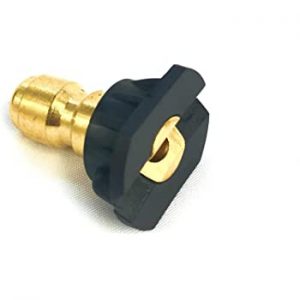
ROTARY OR TURBO NOZZLE
The rotary nozzle is an alternative to the red nozzle. It exerts the same pressure as the red nozzle does. However, it possesses the spray angle of the green nozzle. The pulsing action rotates the water in a circular motion to release a jet stream of 1800-3000 rpm, which makes it blast so fast that it hits the surface as a cone shape. This 4-8- inch spray circle allows for quick cleaning with high pressure.
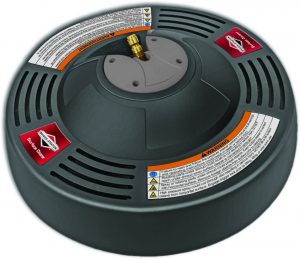
A rotary or turbo nozzle is capable of cleaning stubborn dirt from concrete, thick grime, strip paint, and can even remove gum from sidewalks.
HOW DO NOZZLE TIPS AFFECT WATER PRESSURE
Pressure washer nozzles control the angle of the spraying fan and how much water is allowed to pass through the opening. Although nozzles can determine the water pressure, they are not capable of increasing the force above the capacity of the pressure washer. Nozzles that have small openings are capable of spraying with a higher pressure than a wide opening because a smaller amount of water passes through the smaller opening, which causes the increased pressure.
CONCLUSION
As always, ensure that you use the right tool for the job. For example, a green nozzle will be too tough to clean a car or to use along with chemicals and may damage the surface. Also, be careful when using these nozzle tips as they are quite powerful. Each of these nozzles has its specific design and uses and should not be missed to avoid damaging your surfaces, car, or even your driveway. Also see pressure washer uses.
